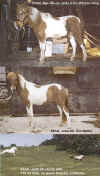
Treating Founder (Chronic Laminitis) without Horseshoes, Section 10
Faster-loading version with "thumbnail" photos
(Click on small photos to see larger versions)
Dr. Frederick has had excellent results on laminitic horses IF they are treated immediately, while still in the acute phase. Once this window of opportunity is passed, you will have some longer-lasting damage. His strategy is necessarily designed to work in situations where he has little control--ie, clients having stalled horses, and poor client compliance on farrier care. Some of the neglected horses photographed on this site were clients whose horses were only trimmed when he came out to do the annual shots! So he relies on drugs more that would not be necessary for horses with free, natural living conditions and ideal trims maintained often. He does state that he has had the best results with horses whose shoes are pulled and who are housed in a large sandy arena with another horse for company and a reason to move, and the hay in little piles here and there to encourage movement. And the worst results with horses constantly stalled with thin bedding over concrete floors.
Dr. Strasser agrees with him on keeping the horse moving, and in walking the horse in a cold creek or in mud during an acute episode. She emphasizes the need for keeping the horse moving even more than he does.
The animal must be taken away from the trigger. Gorging on the new spring grass must be stopped, for instance. (He also tells me laminitis is experimentally induced by researchers by overfeeding concentrated carbohydrates--or black walnut extract, which is toxic.) He has seen many cases that were brought on by overfeeding alfalfa hay and/or grain. Other cases were triggered by poisonous plants in the pasture: nightshade, leaves and acorns from oak, black walnut, wild cherry, red maple. To have a more complete list of toxic plants found in pastures, with photo links, click on the link below:
http://www.ansci.cornell.edu/plants/
Click here to see Dr. Frederick's article on treating acute laminitis
More on grass founder: www.safergrass.org
This site discusses the effects of different types of carbohydrates in grasses, insulin resistance, Cushings disease, fructans, Equine Polysaccharide Storage Myopathy (EPSM), carbohydrate intolerance, metabolic acidiosis, Non Fiber Carbs, glycemic indexes of forages, the benefits of soaking hay to reduce sugars, etc. She found that "the leading researchers and breeders of pasture grasses were focused increasing the nutrient density of new varieties of forage to maximize milk production and weight gain in cattle, and had not heard of grass founder in horses....To increase palatability, and therefore intake, new varieties of pasture grasses have been purposely selected for high sugar and fructan content, and lower fiber, so they don't feel so full." The end result of grass seeds being developed for these characteristics (and then sold everywhere) is an increase in grass founder in horses. (Seed companies also developed endophyte-infected grass seed because these grasses were more hardy; this, too, opened a Pandora's box of adverse effects on livestock.)
Some of her conclusions:
"As a rule of thumb, stay away from feeds high in sugar, starch and fructan. This will include any grain products, including oats, corn, wheat and barley, distiller by products, molasses. Flaking, cooking or extruded pellets will only increase availability of the starches. Avoid cool season grasses cut for hay in early stages of growth, or during weather stressful to plants, such as drought or frost. Avoid grazing in early heading stage, or during periods of environmental stress. Pectin, hemicellulose and cellulose are safer sources of calories, having a low glycemic response, and are found primarily in beet pulp and soy hulls."
"The most commonly acknowledged cause of laminitis is grain overload. If more sugar or starch is present than the stomach can digest, it overflows into the cecum, or hindgut where fermentation of fiber by microorganisms takes place. Because each type of carbohydrate has specific microorganisms involved in fermentation, this overflow of sugar and starch causes a sudden change in the population dynamics of the gut microbes. Lactic acid bacteria (LAB), that prefer sugar and starch, have a population explosion. There is some disagreement as to which mechanism is responsible for causing the laminitis. It is probable that several mechanisms are involved. The increase in lactic acid formed by the fermentation by LAB causes a massive die off the microbes that were there before. Some used to think this caused endo-toxemia from the massive die off of bacteria and subsequent absorption of the by products from their breakdown. However, recently researchers have found that administration of endotoxins alone do NOT induce laminitis. [20] Other pathogenic bacteria, such as Streptococcus bovis have been implicated, for which starch and fructan are preferred substrates. (Longland and Pollitt) Researchers at the Royal Veterinary College in London have found amine compounds in the hind gut of horses on grass that could trigger vascular changes that occur at the onset of laminitis. [2] [3]"
"Some forms of carb are safer than others. It's the sugar, starch and fructan that we need to limit. Even if your horse is not an easy keeper, you can STILL fatten a horse without having to resort to a high sugar and starch (grain and Supergrass) diet by choosing feeds higher in safer forms of carbohydrates."
This is a really good site! I certainly recommend it to my readers!
Endophyte-infected tall fescue grass is a suspected toxin triggering laminitis. Dr. Dee Cross, of Clemson University, has been testing out the use of domperidone as a preventative, and claims encouraging results. Dr. Cross also notes that fescue toxicosis has been known to lower T3 and T4 thyroid levels. This is truly a difficult problem, as even fields where the fescue has been completely killed off with herbicide and then reseeded with grasses other than fescue, have only stayed endophyte-free 2-3 years...plus it's a really expensive "fix." To quote Dr. Cross: "We would like to do some research using domperidone in a preventive mode because it appears that the alpha 1 adrenoreceptors are being agonized via the alkaloids of toxic fescue. Domperidone is an antagonist to these receptors which keeps the alkaloids from reacting with them."
However, in my own experience, with a field full of fescue that the Agricultural Extension Office assures me is infected, we have had some horses founder on it, and others not. The ones who did not founder tended to be more active--ie, they had more circulation. Some horses who foundered on my fields when shod had not foundered in the past when they were barefoot and worked enough that they wore their hooves down constantly and so did not need trimming. So--I am inclined to believe Dr. Strasser's take on this--that more hoof mechanism will prevent laminitis. I am very leery of giving any prescription drug, like domperidone, forever.
Click here to read Dr. Cross' article on fescue toxicosis
UAA Gel (activated charcoal and clay)--the best remedy for acute laminitis
UAA Gel (Universal Animal Antidote Gel) is made of activated charcoal and clay. It has been used with good effect on acute laminitis. Since so many triggers of laminitis end up creating toxins in the gut, something that adsorbs and neutralizes toxins in the gut makes perfect sense. Sometimes one dose is all that is needed. Avoid over-doing this stuff, as it can have a constipating effect. Also handy if your small animals get into anything toxic, and you are far from a vet, or it's late at night.
One source for purchasing UAA Gel:
http://www.americanlivestock.com/pc-1872-15001-uaa-gel.aspx There are similar products being used by vets and human emergency rooms everywhere for poisoning and drug overdoses. The average horse (1000 lbs.) would need one tube, 300 ml. (300 cc.), of this for one dose. Often, one or 2 doses is all you need. Because it has little taste, there is less resistance to giving this than bute, for instance.
| UAA GEL UNIVERSAL ANIMAL ANTIDOTE GEL SUPER ADSORBENT FORMULA INDICATIONS: For use as emergency first aid for combating poisoning caused by the accidental ingestion of insecticides, herbicides, organic chemicals, and intestinal toxins from bacteria. UAA Gel is also indicated for food poisoning (garbage intoxication) in dogs and cats, and grain overload in ruminants. DESCRIPTION: UAA Gel combines the adsorbent properties of activated hardwood charcoal and thermally processed attapulgite clay to give a highly effective adsorbent suspension that is quick acting and simple to use. UAA Gel is recommended for emergency first aid of oral poisoning in both large and small animals. UAA Gel disperses rapidly in the gastric and intestinal tracts, adsorbing poisons and toxins quickly. RECOMMENDED ORAL DOSAGE: All species 1 to 3 ml per kilogram (2.2 lb.) of body weight. A dose syringe may be used. However, the use of a stomach tube is recommended for comatose or severely debilitated animals. For cattle or Horses, it is recommended that the entire contents of one tube (300 mL) of UAA be given. Proper supportive therapies such as parenteral fluids and injectable antidotes (to counteract the physiological effects of the poison) are recommended as a part of the treatment. If indicated or necessary repeat the dosage of UAA Gel after 1 to 4 hours, or until the symptoms subside. CONTAINS: Activated hardwood charcoal and thermally activated attapulgite clay in aqueous gel suspension. NET CONTENTS: 300 mL. Tube CAUTION: UAA Gel may not be very effective in the treatment of heavy metal poisoning from lead, arsenic, or mercury. |
UAA Gel used in acute laminitis can eliminate the use of bute. Long term bute usage can result in stomach ulcers. I am providing a link to some interesting correspondence with Nancy Filbert, whose pony, Chief, was already rotated 11 degrees after grass founder, got so ulcerated from bute that he stopped eating, and was down all the time. If she gave enough bute to control pain in his feet, it destroyed his stomach. If she withdrew bute, he was too sore to move. This seemingly hopeless situation was turned around with UAA Gel, apple pectin to restore his stomach, some of the supplements I recommended, herd life, constant turnout, and better trimming.
Nancy Filbert's "Chief"--
Better hoof shape and hoof mechanism relieved lameness
and prevented grass founder from recurring.
Letters from Chief's owner on bute, UAA Gel, trimming and apple pectin
(January, 2000 update on Chief--As long as Chief's feet were kept trimmed, he stayed out of trouble. However, because Nancy and Tim's backs were both "out" after an accident for some time this winter, he went 10+ weeks without a new trim. He had a mild mechanical founder in January, 2000 because of the lack of hoof mechanism and increased leverage on his overgrown hooves. He began recovering quickly with another dose of UAA Gel and a trim. Grass founder was not a possible cause at all, as this happened in winter conditions in N. Wisconsin. This serves as a warning--losing hoof mechanism by letting the trim go too long can result in refoundering. If he is maintained with more frequent trims, he does really well, though. An excellent recovery like he had earlier can easily lull an owner into complacency.
I am happy to say that Nancy's experiences helping Chief inspired her to take the Strasser hoofcare certification course; today she is helping a lot of horses in Wisconsin, some initially in worse shape than Chief was. And it all started with a little pony named Chief! He has since died, but he got a new lease on life for many years.
I had another reader who could not seem to find UAA Gel available. She bought some activated charcoal from a chemical company that they normally sold to water filter manufacturers, and gave her horse some. While I admit being nervous about this approach (!), after some charcoal and a proper trim her horse was doing much, much better in record time. I have no idea what the proper dosage is, though, going this route, and overdosing with charcoal can constipate a horse.
Finally, I have heard of some of my readers getting something similar called Toxi-Ban from Jeffers: 1-800-JEFFERS. They were delighted with how quickly it knocked out acute laminitis episodes. It is the "charcoal treatment" listed in the First Aid section of their pet catalog. You can also have it shipped overnight via FedEx. Also, the recommended dosages on the bottle suggest you need 20-25 bottles for a 1000 lb. horse, which is excessive and unnecessary. The people I have heard from have gotten good results on much lower doses, like 1 or 2 bottles. However, UAA Gel is far simpler to use because it is more concentrated.
Dr. Frederick's explanation of grass founder:
Gorging on the rich new spring grass, or on concentrated carbohydrates, both raise the acidity in the gut suddenly. This sudden increase in gut acidity results in a massive die-off of normal gut bacteria. The poisonous by-products of these dead bacteria, endotoxins, cause inflammation and edema in the laminae. Specifically, he mentioned that both the new grass--and foundered horses--have higher lactic acid levels. Later in this article, I will talk about Pat Coleby's recommendations for treating acute laminitis--administering Epsom salts, which makes gut ph less acidic, and whose laxative effect clears out a digestive tract that is filled with endotoxins. (This is a good thing to give along with charcoal, to counteract the constipating effect.) Her good results doing this could be explained by the above scenario. She also recommends daily preventative doses of dolomite, which also reduces acidity, while supplying extra calcium and magnesium. DMG also helps lower lactic acid makes it an additional means for both prevention and treatment.
However, the fastest fix for acute laminitis due to gut toxins is removing the trigger (ie, new grass) and giving UAA Gel (activated charcoal)....coupled with a correct barefoot trim and plenty of movement in a turnout situation.
The Role of Gut Disturbances in Laminitis
Many laminitis cases have in common gut disturbances that result in a massive die-off of the benign intestinal bacteria. When you have a massive die-off of intestinal bacteria, they decompose inside the gut, releasing toxins. Toxins can lead to an inflammatory response in the feet...laminitis. Direct exposure to toxins via other means--retained placenta beginning to decompose inside a mare, exposure to black walnut via bedding in black walnut shavings, eating black walnut extract, eating poisonous plants like nightshade...can also lead to an inflammatory response. A snake bite is another possible way toxins can be introduced into a horse's body.
One of the most common triggers, though, is new spring grass (high in sugars and low in minerals) or grain overload. Too high an intake of high-sugar content food can acidify the gut, leading to a die-off of benign intestinal bacteria. New spring grass that is low in minerals compounds this acidifying effect.
If you use a product like UAA Gel, or something similar, a 1000 lb. (454 Kg.) horse would get a 300 ml. (about 10 fl. oz.) dose, once or twice during an acute laminitis episode. This is far more effective than buying fish tank filter activated charcoal, as the filter charcoal particles are much coarser. This link is for purchasing it: http://www.jefferslivestock.com/ssc/product.asp?CID=2&pf_id=0032408 It is similar to what is used in ERs for drug overdoses, etc. I would want to get some in ASAP during an acute laminitis episode, but I wouldn't dose too many times, as it can be constipating. Constipation can lead to other problems, such as colic...
Here is an interesting quote from the pipevet.com site, which caters to sheep growers: http://www.pipevet.com/articles/overeating_disease.htm Although this excerpt is from an article about sheep, sheep can also get laminitis from grain overload, as horses can:
| "Grain Overload. This is strictly a management disease where lambs are allowed to engorge a large amount of grain or when we change rations quickly. Sheep, along with other ruminants, need to be kept on a regular diet. If they are suddenly allowed uncontrolled access to grain the grain rapidly ferments in the rumen. This drops the pH of the rumen and causes, dehydration, lowering of blood pH and acid burns to the rumen wall. If severe this can result in a quick death. If the sheep survives the rapid change in pH the next problems that can develop are laminitis (founder) and polioencephalomalacia. Weeks after the incident the lamb can still be affected by liver abscess and poor growth rate due to severe damage of the rumen. If caught in the early stages grain overload can be drenched with sodium bicarbonate in cold water. The sodium bicarbonate will buffer the pH change and cold water will slow the fermentation process. Activated charcoal is also used to bind the starch and prevent further fermentation. Banamine and dexamethasone are useful to treat inflammation, pain and shock. If the lamb lives more than 24 hours it should be fed grass hay and probiotics to stimulate the rumen, treated with B complex vitamins to prevent polioencephalomalcia and treated with long-acting penicillin or tetracycline to prevent liver abscess for 2 weeks. Prevention is much easier than treatment. Changing rations gradually, secure gate latches and sheep proof feed storage can easily prevent grain overload. J. L. Goelz, D.V.M. Vol. 22. No. 4, June 2002" |
Dr. Goelz mentions the gut becoming more acid. Several other laminitis triggers also involve a more acid gut--over-exertion, road founder and stress (lactic acid build-up). Over-eating new spring grass, which is sugary and mineral-poor also makes the gut more acid. This overly acid gut can result in a massive die-off of benign intestinal bacteria.
Many horse owners unwittingly set rescue horses up for laminitis by overfeeding grain to speed up weight gain. Many of these horses have leaky gut syndrome, and/or ulcers, and benefit from routine use of products like Vitaroyal's Nutrient Buffer: http://www.vitaroyal.com/equine/products/nutrient_buffer.html and probiotics. This plus a quality diet low in simple sugars is the safer approach to building a horse back up. Sweet feed loaded with molasses is a really bad idea for helping a thin horse gain weight.
Antibiotics used aggressively can also result in a massive intestinal die-off of the benign gut bacteria. Worming may also disturb the gut flora. Fevers can kill off benign gut bacteria. So can colic. Getting too many vaccines at once can sometimes cause adverse reactions as well. The grand old tradition of "spring shots": many vaccines, tube worming, and anesthetic for floating teeth, all given on the same day, is just too much stress for some horses. This may be behind why founder is more common in the spring even among horses not turned out on grass.
One of the things you can do to reduce an animal's susceptibility to gut disturbances is to supplement with probiotics routinely. You can also get your forage and water analyzed for mineral imbalances or deficiencies that can be corrected via supplements. Water pH is also of interest. High iron content in water is inflammatory, and an often over-looked factor.
Road founder does have a mechanical component--the laminae being over-stressed by continual pounding and overwork--but stress and over-exertion can also lead to a more acid gut due to lactic acid buildup. Rough hauls in the trailer also combine over-exertion and stress to stay balanced in a moving trailer...leading to the gut becoming more acid, followed by a massive die-off of gut bacteria.
Trying to reestablish healthy gut bacteria can be speeded up with probiotics. Dr. Kellon recommends two different pro-biotic products: The difference between Ration Plus and Equine Generator is that Ration Plus contains growth factors that encourage the good bacteria, no actual bacteria in it, while the EquineGenerator contains generous amounts of live bacteria to replace populations.
Equine Generator--a stronger product with live bacteria, to be used initially after a massive gut bacterial die-off: http://www.bio-vet.com/equineproducts.htm
Ration Plus, what you can use routinely afterwards, after jump-starting with Equine Generator or something similar containing live bacteria: http://www.rationplus.com/purchase_horse2.html Even healthy horses can benefit from the routine use of digestive aids.
New!!! Dr. Kellon's article on FEEDING THE HOOF
Dr. Strasser on grass founder:
Dr. Strasser has found that once she restores optimal circulation and the coffin bone in a ground-parallel position in horses which had previously grass foundered, that these horses can get away with normal grazing. She actually feels the coffin bone being out of a ground-parallel position is the biggest causative factor. Laminitis is basically a chronic circulatory deficiency in the feet because of shoeing, high heels, contraction and lack of activity. Correcting these factors enables horses to better withstand triggers like grazing lush grass. Developing more circulation through a constantly maintained wild horse hoof shape and lots of exercise is a great prevention.
This is in line with the findings of Jaime Jackson and others studying wild horse feet. They were hard pressed to find any freshly captured wild horses who were foundered.
FounderGuard (virginiamycin) is being promoted in some circles as a preventive measure for grass founder, but I have reservations about the long-term use of antibiotics. This is giving a low level of antibiotics continually to kill off the rise in the wrong kinds of gut bacteria that result from carbohydrate overload. The manufacturer assures us that this is a very narrow-spectrum drug that targets just the problematic bacteria in the gut. Other literature suggests that this is a broader-spectrum antibiotic that can also adversely effect the benign bacteria in the gut needed for digestion.
Here is a real-life example of Nancy Filbert's pony, Chief, getting away with a lot more grazing after his trim was improved. Chief had been foundered so badly that he was down most of the time, and was eating and drinking less and less after pain-killers gave him ulcers. What turned this around was correct trimming, a couple doses of activated charcoal, more activity and discontinuing pain-killers.
| -----Original Message----- From: Nancy Filbert wenfil@newnorth.net To: Gretchen Fathauer gretchenfathauer@ee.net Date: Thursday, November 11, 1999 6:50 PM Subject: Long lost me Hi Gretchen! This is Nancy Filbert, Chief's mom. Chief is doing fabulous. I would dare to bet he has complete reattachment of his coffin bone. He has no obvious lameness. Vets and other people can't believe it. I am grazing him 2-3 hours a day on grass and he is not re-foundering. Hoof function is the key. What Sabine taught us is incredible. Even though the grass is dead now, keep in mind he foundered 2 times on it last fall. Now, he is able to eat it. I remember last spring when he was real sick, I dreamed that one day he would feel good enough to break out of the fence again (he is a fence tester). Did I eat my words this summer! Chief was out on fresh green grass for unknown amounts of time. I'd come back from work and he'd be out. Never bothered him a bit. I can't believe I am writing this! Had to wrap 4-5 wires around his pen. I am not giving him any supplements besides vitamins now. Gretchen, I am so busy, it is sad. It is all I can do to keep up with life and take good care of our animals. Any free time that Tim and I have, believe it our not, we spend trimming and helping foundered horses and ponies in our area. The work we are doing is unreal. It is so incredible to see these poor animals regain their lives back. Bye for now, dear person and friend! Give Max a big hug for me! Sincerely, Nancy Filbert |
On a personal note, I have been able to let Max graze a lot more without repercussions since I started doing a Strasser trim on him.
The Grazing Muzzle Option
Some people want to be absolutely sure their horses do not overindulge in new spring grass, and use grazing muzzles during turnout if they have especially large, lush pastures. While restoring and constantly maintaining hoof mechanism may be all you need to do to prevent grass founder, some people want these as an added insurance policy. I cannot say I am too enthusiastic about these, but if there are doubts that your horse really has hoof mechanism, and your fields are really large and lush, these may be an option. These cannot be left on all the time, as the horse may have difficulty drinking, and getting at salt licks. You also want to take them off when feeding hay to encourage eating more hay. I have heard of horses actually wearing gouges into their front teeth from cage-shaped metal grazing muzzles, and would advise against these. One web site to check out: http://www.bestfriendequine.com/
This muzzle snaps on over the halter noseband in 4 places.
Some observations on grass founder by Eleanor Kellon, VMD, technical editor of The Horse Journal:
| I'd like to take a minute to run through the metabolism and grass founder connection. There are now several studies that have shown that ponies and some horses - whether they have a history of founder or not - have "abnormal" glucose tolerance. What this amounts to is their cells being less sensitive to insulin than other domesticated horses. When they eat a meal high in easily digested carbohydrates (grain or lush grass, especially rapid young growths), their blood sugar and their insulin elevate much higher than a 'normal' horse. This is the same thing that happens in adult onset diabetes in people, at least in the early stages. The problem isn't too little insulin (like in the type of diabetes where people get insulin shots every day), it is that the cells are not sensitive enough to insulin. I personally believe this is a natural adaptation in the hardy breeds like ponies, Arabs and Morgans that allows them to survive well on sparse vegetation. By being relatively insensitive to insulin, their blood sugar remains more stable, ensuring a constant supply of glucose to critical organs like the brain and heart. They only get into problems when domestication restricts their exercise (another great way to keep your blood sugars level) and provides them with a diet that is much more sugar-dense than they are made to handle. High insulin (triggered by the high sugar content of the diet) slows the metabolism and shifts it over to fat storing. This is why these breeds are such easy keepers and gain weight quickly on even small amounts of carbohydrate/sugar (there are many different types of sugars in plants and grains, not all "sweet"). Another consequence of this altered metabolism is that the arteries become more sensitive to a chemical in the blood called thromboxane and will go into spasm more easily. This vasoconstrictive (constricted blood vessels) phase of founder is well documented. The combination of restricted exercise and shod feet, or feet that are improperly trimmed, and a tendency for the arteries to spasm easily is probably a key factor in laminitis developing although other factors, including allergy, could be involved as well. I mentioned magnesium in an earlier post. Magnesium is the most ignored of all the key minerals and deficiencies are likely widespread. Soil types, grass types (especially legumes like alfalfa or clover) and environmental problems (acid rain) all contribute. Magnesium is involved in literally hundreds of enzyme reactions, including those needed to properly process glucose. It is a well known fact that diabetes are commonly deficient in magnesium and magnesium increases insulin sensitivity. Magnesium is also important for stabilizing cell membranes and membranes inside cells. It will often help alleviate allergic reactions. Finally, magnesium can desensitize the vessels to thromboxane so that they relax and do not go into spasm. |
Linsey McLean, the biochemist who formulates the VitaRoyal products, is treating founder-prone horses nutritionally as hypoglycemics with allergy problems, with encouraging results.
In addition to specific nutritional supplements, she recommends a higher-protein and fat, and lower sugar diet.
To read an article on her recommendations, click here for Linsey McLean on founder
Varying degrees of susceptibility
My mule's former owners tell me he broke into the barn and ate 50 lbs. of grain in one sitting. This would be enough to founder most horses! He did not get sick, and has never foundered. I believe what may have saved him was that he was young, lean, and very active chasing the cattle in his 30 acre field day and night. This was the main reason they sold him, actually--they were tired of him running the cows ragged. All this exercise is good for the circulation in his feet, which have always been unshod. These factors gave him enough circulation to weather this storm successfully.
Another advantage Schmo had, being a mule, is that mules have large, prominent frogs somewhat further back, where they are better able to have hoof mechanism. While mules can and do founder, they are less likely to because of their more prominent frogs.
Freshly captured wild mule, fore feet, photo courtesy of Jaime Jackson
My draft mule's feet, in February of 2005. LH above, RF below.
Shows how prominent mule frogs are. Never been lame.
Schmo (1/2 Belgian Draft Horse, 1/2 Giant Donkey). Shows some
elements of donkey foot shape, like thick walls, more oval footprint,
quarters not much wider than heels, and more concavity.
He has a 30 degree hairline slope, like a horse, though.
This agrees with Dr. Strasser's take on this...that all lamintis is preceded by poor circulation due to high, contracted hooves and lack of activity. Foundered horses whose hooves she has restored to full functionality have been able to withstand triggers that used to founder them. Grass-foundered horses were able to graze again without foundering. Sabine Kells tells me of horses she has been trimming making a grain room raids, with no repercussions.
Several vets, farriers and breeders have told me that certain family lines of horses are more founder-prone, while some lines never founder. They all knew of some family lines where every horse foundered as they got older. Others, kept in the same conditions and fed the same diet, never foundered. One wonders, though, if the more founder-prone lines were less active.
Further, it is well-known that founder is more common during spring and fall, which are usually rainier. The usual explanation is that this is because the grass is more lush. Another often-overlooked factor at work during the rainier seasons, though, is that soft, muddy ground does not offer enough firmness to give good hoof mechanism. There is nothing forcing the heels apart and pumping the frog with each step if the ground is super-soft. This is one reason why Dr. Strasser has often has harder-hoofed breeds walked on firmer ground, even blacktop, when they are her patients. The footing in her clinic is non-concussive, but FIRM. Once the hooves have been trimmed to get the bottoms of the coffin bones ground-parallel, you are not risking sole penetration walking the horses more, even on firm ground.
Another stress often overlooked are "spring shots." I am convinced that there is a connection between so many horses foundering in the spring, and "spring shots." I am hearing more lately about antibody titre tests showing that in fact immunity from many of the shots lasts considerably longer than one year. Plus I believe that vaccinating for too many different diseases on the same day is too much; these shots should be broken up by a few weeks. Yet it is common to have tube worming, tranquilizing to facilitate sheath cleaning and floating, plus a large number of shots--all done on the same day. This is just hitting them with too much at once! There have been a few times when my animals have had adverse reactions to spring shots--ranging from 2-3 days of fever to sore, greatly swollen injection sites. Other years everything seems to go well, but not always.
There does seem to be a connection, though, between obesity and founder. Obesity promotes founder 3 ways:
1. Fat horses' greater weight puts more stress on the feet.
2. Fat horses move around less, and activity improves circulation in the feet.
3. Fat stores toxins longer than tissues with greater circulation, such as muscle tissue.
Other founder triggers:
Systemic upsets--infection, colic, retained placenta, toxins, even diet changes, drinking too much cold water when hot--anything that can upset the digestive process--is a possibility. Anything toxic also a possibility. Giving too many steroids or antibiotics can do it, too.
Road Founder--combines both mechanical and systemic causes. The mechanical tearing at the laminae from excessive hard work on hard surfaces is one cause. The mechanical tearing is made worse by the increased leverage of an overlong toe. High heels put more weight and stress on the laminae in the toe area. The systemic aspect from over-exertion is the build-up of lactic acid, favoring acid-loving bacteria in the gut rather than normal gut bacteria.
Hoof Abscesses--a common sequel to laminitis:
If there has been significant damage and tissue destruction from acute laminitis, too much to be cleared by normal circulation, abscesses will form. This is to be expected and is part of the healing process. It is how the body gets rid of dead and damaged tissue.
In horses who have had large solar abscesses that have cut off circulation to the frog and sole, you may have an entire outer layer of frog and sole start to peel off, pus and blood oozing out, with new frog and sole underneath.
Outer layer of frog peeling off, post-abscess. New, sound growth below.
(Photo, courtesy of Rachael Ward Coggins)
Hoof abscess exits growing out. Abscesses exited twice from
coronet band earlier; also through white line in toe. 4-15-2001.
6 weeks later, 5-31-2001, I summoned the courage to do a resection--in other words, to remove loose wall. The abscess exit had grown down considerably in 6 weeks. When I first uncovered the laminae that were under the loose, curling horn, they were black and smelled abscessy even though they had quit draining for some time. I think this cavity was trapping dirt and infection. The idea of a resection sounds like a formidable medical procedure, but I only viewed it as removing loose wall, and rasping out sharp edges and flares. Overnight the laminae dried out. I proceeded very slowly and carefully; the horse was not even tied, but eating hay loose in the aisle. No sedation or painkillers were used or needed. The horse was not sore afterwards. No special medications or bandaging were used in this case. I see what I did as damage control; I wanted to stop loose wall from leveraging sound hoof wall that was still well attached, and I did not want corners catching and ripping on anything. Actually, on the front view, I filed a tiny bit more weak, flared toe in the corner on your left after the photos were taken.
Abscessing is not a cause for panic, but a sign of progress, hard as this idea is to assimilate! The new frog and sole horn will grow very rapidly, but initially be soft and poor-quality horn. This will eventually improve, though, with time and restored circulation. Using hoof boots or taped on pads for exercise sessions may be helpful in these early stages of recovery. Soaking the feet at least once a day in warm water with apple cider vinegar can help draw out infection and soften the hoof enough to allow the abscess to break out. Once the abscess has burst, the horse will be more comfortable.
Dr. Strasser on hoof abscesses, from Jaime Jackson's newsletter:
| Dr. Strasser on hoof abscesses:
"A hoof abscess is a purulent inflammation of the corium, where the pressure produced by the accumulation of pus between the corium and the hoof causes the horse great pain and leads to pronounced lameness. "According to conventional educated opinion, a hoof abscess occurs when the horse has pierced the sole with a foreign object--that is, the abscess occurs through infection from the outside. "Hoof abscesses, however, only very rarely arise due to external infecting agents. More commonly, the following occurs: Corium or lateral cartilage areas, which have been compressed for a long time, die off. [Gretchen Fathauer's note--compression of corium, etc., often is the result of contracted feet and the tip of a tilted coffin bone pressing on the toe area sole corium.] After circulation is returned to these areas, the dead pieces of tissue are removed from the living tissue and carried to the outside by pus, since the dead pieces of tissue cannot be transported away through the microscopically small blood vessels in the corrium. "THIS PROCESS IS VERY COMMON IN THE TRANSITION FROM SHOD HOOF TO BAREFOOT. "When contracted hooves open, sole and heel abscesses must be expected. They predominantly are found in the area of the heels and bars, and sometimes also by the frog, especially near the tip. They also form in places where shoes' clips are, and near the rearmost nails. Often excessively long bars which have grown over the sole cause pressure points which later become noticeable as abscesses. [She then talks about surgically opening abscesses. This, however, should only be done by an expert. Please keep in mind that not all vets have enough experience doing this to actually BE experts at this, however. There is potential for damaging the corium by carving out too much sole, and it makes for a longer recovery when not done well. She also talks about keeping the horse moving on soft ground as being helpful because it increases circulation.] "Sometimes a hoof abscess cannot be found, for example if it is deep in the heel/frog/bars region. In this case, rather than cutting away a large part of the sole or frog (it would be a long time before the horse could bear weight on this foot again!), applying bandaging and leaving the horse in a box--as is often done--one should wait until the abscess finds its own way to the outside. Poultices with warm linseed mush, which soften the horn, are helpful. The pain will lessen as soon as the pus comes out by the coronary band; however, this can take a few days. "For several days afterward one should bathe the hoof daily in water with a bit of fruit [apple cider] vinegar. Natural hooves with normal circulation (and therefore good blood supply) are very regenerative." |
Dr. Eleanor Kellon posted some interesting information on abscesses on the naturalhorsetrim list responding to a post:
| "Part of the problem is that subsolar collections are often in separately walled off 'pockets,' so that when you get drainage that may not be the entire extent of the problem. Some horses are without symptoms because their collection has a small avenue for drainage (around the tip of the frog is a common place, or at the seat of the corn). You may never know it's happening and it doesn't take much drainage to relieve the pressure enough to make the horse comfortable. If for some reason (e.g. inflammatory reaction) that avenue for pressure release becomes sealed off, symptoms will appear. "Another thing that contributes to abscesses/collections not draining properly is poor hoof mechanics. His feet in those last photos were underrun. Conversely, a physiologically sound trim very often gets the collections mobilized. "Hot soaks or hot poultices do help. My favorite for a poultice is Numotizine, www.numotizine.com. In addition to being antibacterial, if you make sure the foot is scrubbed clean before applying it, it will change color from the pink-grey initially to green, brown or black anywhere there is drainage/seepage. It has helped me zero in on problem locations. --Eleanor " |
For pain relief during abscessing periods, you might try No-Bute, an herbal anti-inflammatory, rather than using bute, or stronger drugs. For more info: Click HERE I have gotten a lot of good reports about it, and it does not have toxic side effects that a lot of drugs do.
Resections are not always 'unnatural' and 'invasive!' In a hoof with serious detachment, when the hoof capsule is in danger of sloughing off, a resection can be a 'controlled slough.' In other words, it can remove wall that is harboring infection in 'gas pockets' (voids between the wall and laminae), remove wall that is crushing the blood supply because of excessive rotation, and remove wall that could snag on something and pull the whole hoof capsule off.
Below is the case of horse in New Zealand named Cracker, who was a 'sinker.' I was consulted via email on this case. They did a barefoot approach, keeping pads cut out of garden kneelers taped onto the feet with duct tape, rather than shoeing her. While the mare was in rough shape and down a lot, she was slowly improving in terms of new attachment coming in better, and sole penetration healing. (Eventually they put her down, though, because of continued pain and abscessing.) Their vet did the resection, but they did their own trimming.
The remaining toe wall was crushing circulation in the toe. They did not resect both toes--only the worst. Photos from before, early 2006, and in May, 2006, showing acceptable toe wall growth coming back in on the resected hoof, but not the 'good' hoof that wasn't resected:
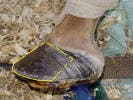
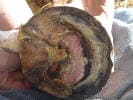
Cracker before resection, February 2006; rotated toe wall was crushing corium,
and she had extensive sole penetration (in late January). I drew yellow dotted lines
around detached area, which was detached on both sides.
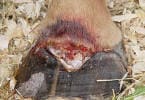
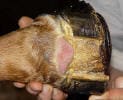
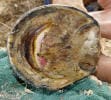
Initial grooving, which I advised them was not enough, and too sharp-edged.
Center, their next step which was an improvement. Soon after
this was done, dark, greenish, dead, foul-smelling tissue turned pink and healthy.
(I understand they took some more off later of the loose 'cafe door' walls.)
Sole starting to re-grow, right, as of early March, 2006.
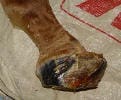
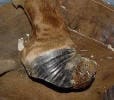
May, 2006. "Better' hoof, left, not resected, doing worse
than 'worse' hoof, right, which was resected. There is
still quite a bit that could come off the toe profiles on both.
(Photos, Viv MacFarlane)
Back to home page--Table of Contents
Article in sections with "thumbnail" photos for fastest downloads:
1 9 17
2 10 18
3 11 19
4 12 20
5 13 21
6 14 22
7 15 23
8 16 24
NAVICULAR
Article in sections with full-sized photos for print-outs:
1 9 17
2 10 18
3 11 19
4 12 20
5 13 21
6 14 22
7 15 23
8 16 24
NAVICULAR
To Strasser case studies--thumbnail photos for faster downloads
To Strasser case studies--large photos
Please sign my guest book! Photos of my pets My farm
Share Barefoot success stories on this page
Buy or sell used HORSE BOOTS Natural board Barn Listings
Click here to subscribe to naturalhorsetrim
(I moderate this listserv to weed out "fluff.")
Send Email to Gretchen Fathauer, or call (740) 674-4492
Copyright by Gretchen Fathauer, 2018. All rights reserved.